| PROTO-POLYNESIAN ETYMOLOGIES |
| *Piu [Proto Polynesian] |
Pritchardia pacifica, "Pacific Fan Palm" (Arecaceae). |
|
From PROTO MALAYO-POLYNESIAN *biRu', "fan palm, Licuala rumphii",
through PROTO OCEANIC *piRu('), "fan palm, Licuala sp. ",
PROTO EASTERN OCEANIC *piRu('), generic term for fan & umbrella palms,
and PROTO CENTRAL PACIFIC *viu, "fan palm, umbrella palm, Pritchardia Pacifica",
through PROTO POLYNESIAN *piu, "Pacific fan palm, Pritchardia pacifica ". |
Proto Polynesian: *Piu
REFLEXES IN SOME POLYNESIAN LANGUAGES:
Tongan, Niuean, Samoan & Tokelauan: Piu - more properly niu piu in Samoa and Tonga - (Pritchardia pacifica, "Pacific Fan Palm", Arecaceae)
Tuamotuan: Piupiu (Tournefortia argentea, "Beach Heliotrope", Boraginaceae)
Maori: Piupiu (Generic name for several species of fern with palm-like fronds.) |
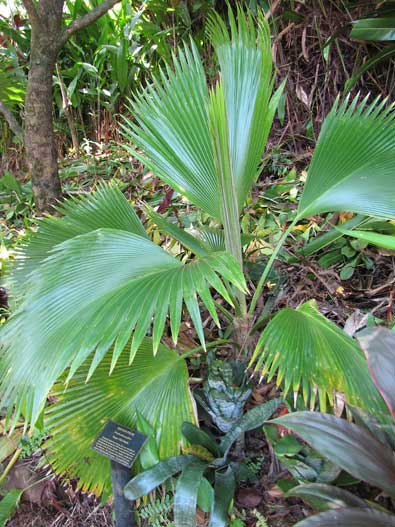
Prichardia pacifica - Piu
(Young plant)
(Garden of Eden, Keanae, Maui, Hawaii. Photo: Forest & Kim Starr) |
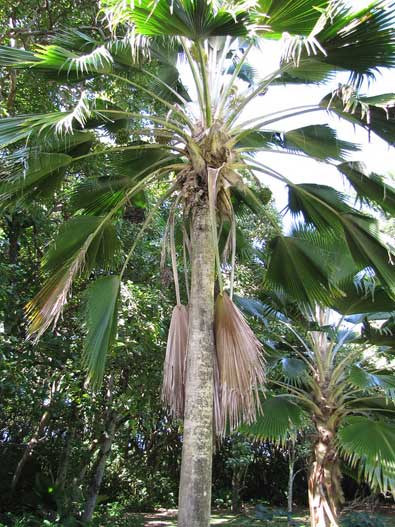
Prichardia pacifica - Piu
(Kahanu Gardens, NTBG, Hana, Maui, Photo: Forest & Kim Starr.) |
|
COGNATE REFLEXES IN SOME OTHER AUSTRONESIAN LANGUAGES
Kove (Northern New Guinea): Pilu (Licuala sp. "Fan palm", Arecaceae)
Gila (South-east Solomons): Vilu ("Species of palm with umbrella-like leaves")
Bauan (Fiji): Viu (Pritchardia Pacifica, "Pacific Fan Palm", Arecaceae) |
|
|
|
This is a name that seems to have originated in Sulawesi (the Celebes), as the speakers of Proto Malayo Polynesian moved south from the Philippines into what is now Indonesia. It seems first to have designated the Celebes Fan Palm, Licuala rumphii, and then, as Austronesian speakers moved along the Northern New Guinea Coast and into the Pacific, the word evolved in sound and meaning from *biRu' to *piRu' (Proto-Oceanic), probably designating members of the genus Licuala in general, then *piru (Proto Eastern Oceanic) as a general term for fan and umbrella palms. In the Fiji/Rotuma area there was a further change in sound and meaning to Proto Central Pacific *viu, denoting the Pacific fan palm Pritchardia pacifica; this latter meaning was retained in Polynesia under the form *piu.
Licuala rumphii is a small rainforest palm with wide, wedge-shaped leaflets arranged in circular "fans". Some other species of Licuala have similarly "corrugated" leaves which are not divided. Pritchardia pacifica, native to Fiji and Tonga and some other parts of Polynesia, is a tall, slim fan palm with large, undivided leaves that grows to a height of up to 10 metres (there are a number of closely related species native to Hawaii). It is now grown as an ornamental tree in many places around the world. The seeds of the Pritchardia are edible, and the palm was cultivated in Fiji and Polynesia because of this and the usefulness of the fronds. In Samoa the developing fruit is a kind of snack for children and a famine food for adults. The leaves can serve the purpose of umbrellas or sunshades, and are sometimes used as dance fans. It is also commonly cultivated for decorative purposes.
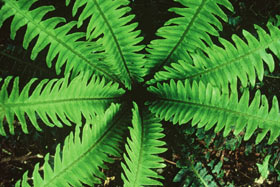 Since there are no umbrella palms native to Aotearoa, it is not surprising that a derivative of the Proto Polynesian name came to refer to several species of fern, mostly with short trunks and a vaguely palm-like appearance. Three of these ferns are members of the Blechnum family (Parablechnum procerum, Lomaria discolor (photograph left) and Parablechnum novaezelandiae [Blechnaceae]. The fourth is Pneumanopteris pennigera, from a different botanical family (Thelypteridaceae). However the use of the same name (piupiu) in the Tuamotus for a tree which at first glance seems far removed from a palm is quite surprising and could simply be a coincidence. However, especially when in flower, the tree concerned, Tournefortia argentea, does have a configuration, in silhouette at least, somewhat reminiscent of the Pritchardia. Since there are no umbrella palms native to Aotearoa, it is not surprising that a derivative of the Proto Polynesian name came to refer to several species of fern, mostly with short trunks and a vaguely palm-like appearance. Three of these ferns are members of the Blechnum family (Parablechnum procerum, Lomaria discolor (photograph left) and Parablechnum novaezelandiae [Blechnaceae]. The fourth is Pneumanopteris pennigera, from a different botanical family (Thelypteridaceae). However the use of the same name (piupiu) in the Tuamotus for a tree which at first glance seems far removed from a palm is quite surprising and could simply be a coincidence. However, especially when in flower, the tree concerned, Tournefortia argentea, does have a configuration, in silhouette at least, somewhat reminiscent of the Pritchardia.
The Pollex database lists the Māori word as cognate but probably borrowed rather than inherited. The same could be said for this palm tree through most of its Polynesian range; Art Whistler thought it was probably native to Tonga, but the palm along with its name was an ancient introduction to Samoa (Plants in Samoan Culture, p. 186). It has also been introduced into the Cook Islands, where it is known as Nū tāmara or Nū Tāmaru ("umbrella palm").
Citation: This page may be cited as R. A. Benton (2022) “Piu [Proto-Polynesian]” (web page periodically updated), Te Māra Reo. "http://www.temarareo.org/PPN-Piu.html" (Date accessed) |
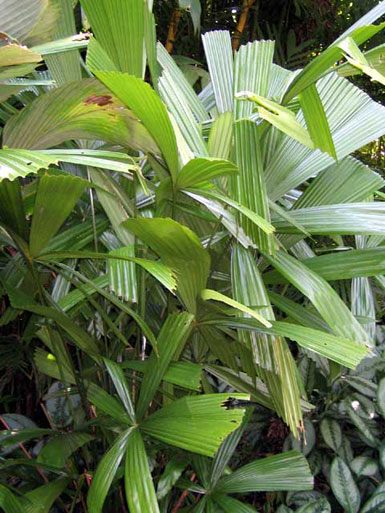
Licuala rumphii - *biRu [Poto-Malayo-Polynesian]
(Sulawesi, Indonesia. Photo: Palm & Cycad Societies of Australia.) |

Tournefprtia argentea - Piupiu (Tuamotu)
(Tahiti. Photo: Plantes boutanique website.) |
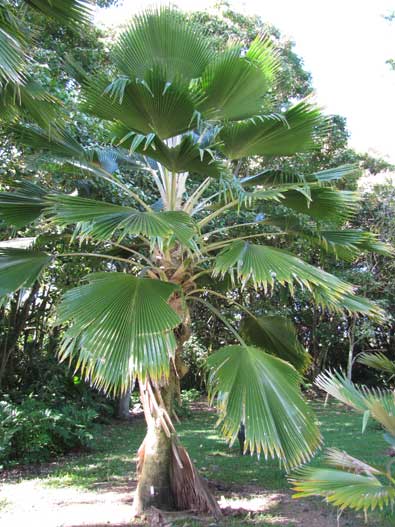
Prichardia pacifica - Piu
(Kahanu Gardens, NTBG, Hana, Maui, Photo: Forest & Kim Starr.) |
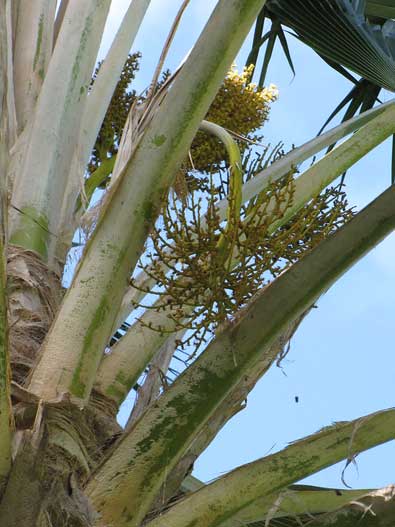
Prichardia pacifica - Piu (Inflorescence)
(Kahanu Gardens, NTBG, Hana, Maui, Photo: Forest & Kim Starr.) |
|
| Further information : The publication details of Art Whistler's book and other publications are in the Bibliography, along with additional material on New Zealand and tropical plants. The Cook Island Biodiversity Network Database and Wikipedia are good places to start looking for more information about the tropical plants. Websites with information on New Zealand plants include Robert Vennell's The Meaning of Trees, the New Zealand Plant Conservation Network, and the Landcare / Manaaki Whenua NZ Flora database, all of which have links to other sources of information. The University of Auckland School of Biological Sciences also has an excellent website dedicated to New Zealand native plants. |
| Photographs: We are grateful to Forest and Kim Starr for the photographs attributed to them in the captions, along with the other sources acknowledged above, and to Landcare Research for the inset photograph of Lomaria discolor. |
|
|

